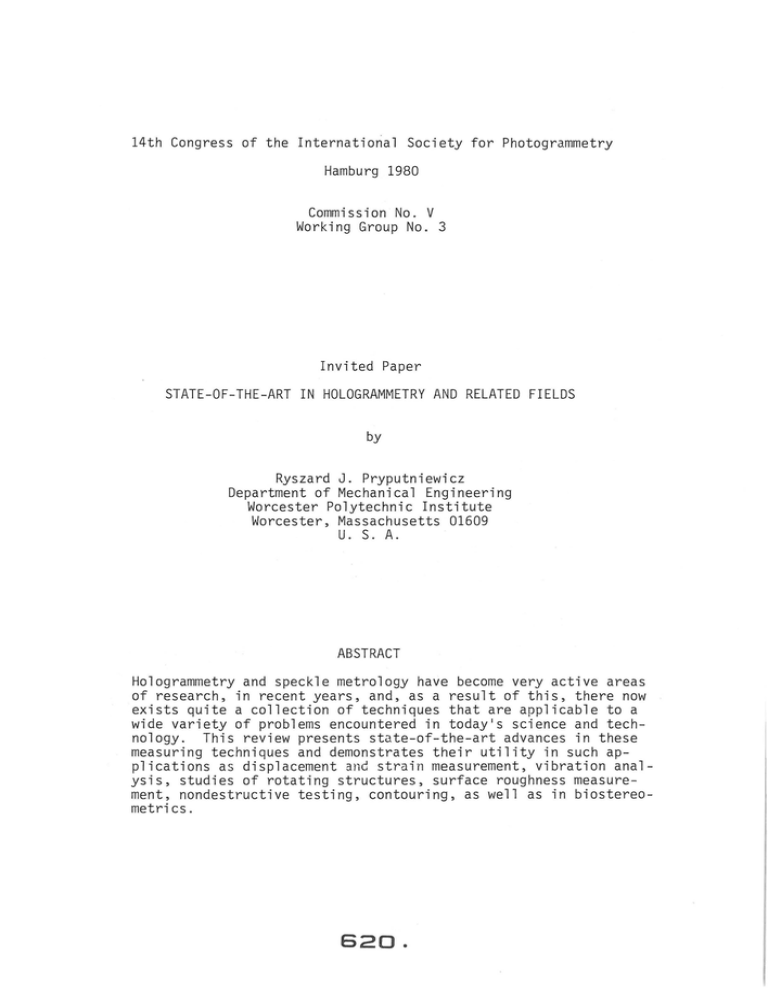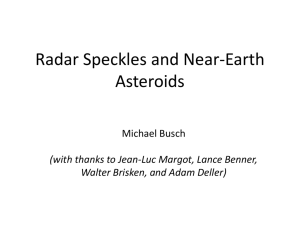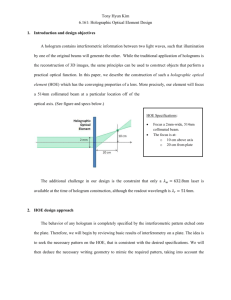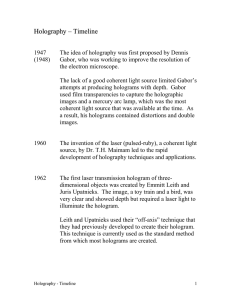14th International No Working
advertisement

14th Congress of the International Society for Photogrammetry
Hamburg 1980
Commission No . V
Working Group No. 3
Invited Paper
STATE-OF-THE-ART IN HOLOGRAMMETRY AND RELATED FIELDS
by
Ryszard J. Pryputniewicz
Department of Mechanical Engineering
Worcester Polytechnic Institute
Worcester, Massachusetts 01609
U. S. A.
ABSTRACT
Hologrammetry and speckle metrology have become very active areas
of research, in recent years, and, as a result of this, there now
exists quite a collection of techniques that are applicable to a
wide variety of problems encountered in today's science and technology . This review presents state-of-the-art advances in these
measuring techniques and demonstrates their utility in such applications as displacement and strain measurement, vibration analysis, studies of rotating structures, surface roughness measure ment, nondestructive testing, contouring, as well as in biostereometrics .
620.
Introduction
In the last decade, hologrammetry and its companion field of speckle metrology have grown tremendously and found numerous applications in such
diverse fields as aerospace , automotive, electronics, machinery, trans portation, equipment, packaging , and other industries, and even in medical
and dental laboratories [1, 2] . All of these advances are well documented
in various publications, too numerous to be even listed in this paper.
And the field is sti ll growing. Constantly, there are new ways found to
apply hologrammetry and speckle metrology to solve problems that were un solvable heretofore, as was excellently summarized by Erf [3, 4], Stetson
[5], and Vest [6] . As new methematical procedures for quantitative interpretation of holograms and specklegrams are developed, it becomes
easier to use these state-of- the - art techniques in various metrologic
applications [7] .
Interpretation of holographic images, however, is based on ones abil i ty
to delineate various parameters such as, for example, dis placement, illumination and observation propagation directions, object surface normals,
normals to fringes , etc . Recent studies [2, 8-10] show that pertinent
relationships between the involved holographic parameters, because of their
vectorial nature, can best be described by projection matrices; the pro jection matrix transforms a vector into its shadow on a surface . These
new formulations allow a straightforward interpretation of holograms with
the aid of programmable hand calculators, thus, reducing ones reliance on
large digital computers for solution of governing equations. Furthermore,
the relationships of hologram in terferometry apply equally well to problems
encountered in speckle metrology [2] .
In the following, these and other most recent developments in hologrammetry and related fields will be presented and their util ity in such ap plications as displacement and strain measurement , surface roughness measurement, contouring, and other areas,will be discussed.
Displacement measurement
The problem of extracting displacements directly from the fringes of hologram interferometry has been solved in a number of ways [11] . Most of
these techniques require multiple observations of the holographically reconstructed image in order to reduce experimental errors . In these cases,
one solves for the three components of the displacement vector that yield
the least-square-error in an attempt to satisfy the overdetermined set of
equations that is generated from the excess data as, for example, discussed
in Reference 12. The above analysis require use of digital computers . The
pertinent equations, however, can be reformulated in terms of projection
matrices and solved on a programmable hand calculator, as discussed below .
It is well known that fringe localization, observed with orthogonal slit
apertures, can be used to determine two components of object displacement
transverse to the observation direction . The vector sum of these two components may be referred to as the observed object di splacement kob· If we
~ake twQ independent observations of the holographic image along directions
K~ and K~, see Fig . 1, then the corresponding observed displacements h6b
and k8b can be related to the total displacement vector k by projection
matrices £1 and e2 , respectively, that is,
621.
R. J. Pryputniewicz (V-3)
~ob = "'pi L
and
(I )
2
2
Lob = "'P L
( 2)
where the projection matrices were defin ed as
Pm
,...,
In Eq. ~.
"m "m
= - !$2
=
!$2
Km® Km
I
,...,
2
2
m =1,2 .
( 3)
RT
indicate s a 3x3 antisymmetric matrix of the unit observation
identityAmatri~,and ~denotes a matric product of
RT with 1tse lf (t he operation KT ~ KT yields a matrixAwhose elements are
all nine possible products of the three components of KT).
vector~~.
l is a 3x3
Neither Eq . 1 nor Eq. 2, by it se lf, can be inverted to yie l d L because of
the singularity of the projection mat rices. Equations 1 and 2 may be combined, however, to yield an overdetermined set of equations
( 4)
which can be solved [2, 9] to yield
L =
[E1
+
E 2 ]-l(~ob
+
2
Lob)
( 5)
Equation 5 yields a value for k whose two proj ec tions onto planes normal
to Ri and R~ have the least-square- error with respect to kbb and kbb· The
above process may be extended to any number of observations by
L =
f f _em]-t( I L~b\
lm=l
m= I
( 6)
}
where r indicates total number of views . Equation 6 allows a straight forward, systematic solut i on for k on a programmable hand calculator .
We should note, at this time, that Eq . 6 applies not only to the cases when
fringe parallax is used in analysis of a holographic image, but also to
cases which require simultaneou s interpretation of two or more independent
holograms of the same object (Fig . 2) and, therefore, when it i s impos sible
to make continuous observations of the image. This latter case arises when
we want to improve the accuracy for determination of the component of ob ject displacement in the viewin g direction, especially if the hologram i s
not very large. Furthermore, Eq. 6 may also be used in speckle metrology
[13] where the magnitude and direction of observed displacements relate
directly to the frequency and orientation of halo fringes .
Strain mea surement
The demand for greater optimization in th e load resisting structures have
created a need for better experimental techniques for accurate mea surement
of structural deformations. Hologrammetry and related techniques are particularly suited for this application becau se they allow rapid, full-surface in spection of a tested object which does not require any special preparation. As a result of thi s , there were many techniques developed for holograph i c analysis of structures . For example, Dandliker et al . [ 14] have
622.
R. J. Pryputniewicz (V - 3)
developed an optoelectronic fringe interpolation technique, whereas
Dubas and Schumann [15] proposed a theory of fringe localization requ i r in g
a complex apparatus of coupled telescops . More recentl~ Stetson [16 -18]
presented a theory, that permits a straightforward determination of homogeneous stra in s of arb itrar il y three -di mens i ona l objects; in the case of
heterogeneous strains - average values are obta ined . We cal l this technique
the fringe vector method of holographic strain ana l ys i s, because it recog nizes that any comb ination of homogeneous strain, shear, and rotation of
an object yields fringes on its surface which can be described by a sing l e
vector . In the fo ll owing, we shal l bri efl y describe this new method and
outline its use in strain ana l ys i s.
If an object undergoes a homogeneous deformation and/or rotatio n during the
recording of a hologram, then, in the reconstruction, the object will be
seen covered by a pattern of fringes that would appear to be generated
along the lines of intersection of the object •s surface with a set of parall el, equa ll y spaced planes (Fig . 3), cal l ed fringe-locus pl anes . The
fringe -l ocus pl anes are uniquely defined by the fringe vec t or whose magnitude is inversely proportional to the spacing between these planes and
whose direction i s normal to th em . As such, the fr in ge vector ~f can be
expressed in terms of the matri x f of stra in s , shears, and rotations of the
object , and the first-order variations of the sensit i vity vector g as [17]
L ,.....g
(7)
where ~ i s the sens iti vity vector defined as the difference between the observat1on and illumin at i on vectors (that i s, ~ = ~ 2 - ~ 1 ) [ 19, 20] , k i s
t he displacement vector , and g is defined as -
g
"'
k
k
= -R p2- -R· PI .
o"'
(8)
I "'
In Eq. 8 Ri and Ro are radii of cu r vature of illumination and observation
perspectives, respectively, while el and £2 represent correspond ing project i on matrices (see Eq. 3) . What we are interested in is the matri x f which
can be decomposed into a matrix of stra in s and shears, g , and a matrix of
rotations, e.
In order to so l ve Eq. 7 for the transformation matr i x f we perform mu l t i ple
observati ons of the holographi~ally reconstructed image. For each observation we determine the sens iti vity vector ~ and , al so, we find the fringe
vecto r ~f that best fits th e data from the entire region examin ed . We al so
use mult1ple vi ews to obta in displacement L of a po int of interest on the
object. Fo r each vi ew , we compute matrix g and multiply it by k to obta in
perspective corrections to ~f· From mu lti pl e vi ews , we obt ain a set of
equations of the type of Eq~ 7, with the matr i x f common to all, which may
be so l ved [18] to obta in
( 9)
where ~fc = ~f - Lg is the matri x formed by the frin ge vectors corrected
for perspect i ve . --Decompos i t i on of the matrix f, computed from Eq. 9,
into the symmetri c part~ and the antisymmetric part e. that i s,
e
= l [t
+
fT]
"'2"""",
e = j_2,....,""
[t - tT]
,....
(I O'I
gi ves strains and shears, and rotations, respectively.
When the object deformations are not homogeneous over the entire body under
study, they may, nonetheless, be approximate l y so over sma ll regions of its
623.
R. J . Pryputniewi cz (V - 3)
surface and projection matrices are very helpful in formulating the solu tion to this problem. It can be shown that, in this case, the surface
strain-rotation matrix fs is
( II )
f 5 = f Pn
""'""'
""'
where Pn is the projection matrix defined as Pn = l - n ® n, with n being
surface normal. It should be noted that the derivatives of observed dis placement are not generally equal to surface strains and rotations of an
object . They, become approximately equal to the extent that the viewing
direction can be made parallel to the surface normal [21]. This condi tion is impossible to achive on any surface that exhibits three -dimension al contours, and it i s diff i cult to achive even on a flat surface because
of the spherical perspective of most viewing systems . However, the derivatives of observed displacement from two or more viewing directions can be
used to extract surface strains and rotations [21].
Contouring
Many engineering problems require preparation of topographical maps of
studied objects and hologrammetric techniques can be used to produce desired contours . This can be demostrated in an elegant wa~ using the de finition of the fringe vector, when we recognize that the projection matrices of Eq. 8 operate on object displacement k via Eq . 7.
Let us assume that the object is illuminated and observed with a spherical
perspective and that both, the illumination and observation, radii are
equal to each other (that is, R0 = Ri = R) . Let us also assume that the
strains and rotations are zero, that is, f = 0. Then, combining Eqs 7 and
8 we obtain
(12)
where kill and kob represent the observed displacements lateral to the illumination and observation directions, respectively, which are defined as
Lill = L
[,! - K, ~K,]
(13)
and
[.!, -
Lob = L
K2 ® K2 ]
(14)
Finally, subst i tution of Eqs 13 and 14 into Eq. 12 and subsequent simpli fication yield
(15)
In topographica l application of hologrammetry we desire to produce fringes
which correspond to depth from the observer . For this condit i on, the
fringe vector ~f must be parallel to the observation direction K2 . If
translation is-to be used to generate contour fringes onAthe object then,
from Eq. 15 it is clear that L must be perpendicular to K1 • The fringes
correspondin g to this translation are generated along the lines of intersection of object 1 s surface with equidistant fringe -l ocus planes which are
normal to the direction of observation. The distance d between these planes
is inversely proportional to the magnitude of tf and is defined as d=n/l~fl ·
Thus, having computed d, we can accurately determine coordinates of any
point on the surface of the object under investigation.
624.
R. J . Pryputniewicz (V-3)
Surface roughness measurement
Recent studies of statistical properties of laser speck l e patterns led to
development of new methods for measurement of surface roughness. When compared with mechanical methods of surface roughness measurement, the speckle
techniques are advantageous because they are noncontact, nondestructive,
are relatively easy to handle, and have potential for mass - production industrial applications .
Depending on the rms roughness to be measured, three different speckle techniques can be distinguished . For measuring fine-scale surface roughness .
less than 0. 25 ~m, the coherent light speckle contrast method is used [22].
For moderate surface roughness, 0.2 - 5 ~m, polychromatic speckle pattern
method applies [23]. Finally, for rough surfaces, 1 - 30 ~m. technique
based on speckle pattern correlation gives the best results [24]. Since
speckle pattern correlation technique would have most extensive photogrammetric applications, it will be briefly discussed herein, for discussion
of the other two methods References 4, 22, and 23 should be consulted.
In the speckle pattern correlation method, the rough surface under examination is illuminated by a coherent plane wave from a laser, Fig. 4a . The
speckle pattern produced by a wave incident on the surface is recorded, in
the Fraunhofer diffraction region, in a suitable photographic emulsion
placed normal to the direction defined by an angle 82 . Then, the angle of
incidence is varied by a small amount 88 1 and a second exposure is made on
the same emulsion . This change of the incidence angle from 8 1 to 8 1 +88 1
produces a decrease in correlation between the two speckle patterns which
is a function of the surface roughness. The degree of correlation is di rectly related to the visibil ity of Young's fringes (Fio. 4b), which are
produced at the focal plane of a reconstructing lens (Fig . 4c). from the
two speckle patterns recorded in the film. Visibi li ty V of these fringes
is related to the surface roughness Rs by
V = .!..exp{-.!..[(27T)sin(8, + 82)R 8e]2}.
(16)
A.
cos82
s
'
Equation 16 clearly indicates that surface roughness can be measured by
determining the vis i bility of Young's fringes as a function of 88 1 when
the geometric parameters 8 1 and 82 as well as the wavelength A are fixed .
2
2
Other representative appl i cations of hologrammetry
Hologrammetry is finding ever increasing applicat i on in vibrat i on analysis,
because of the simplicity of the method. We merely need to vibrate the
object while making a hologram of it, develop the hologram, and observe
the reconstruction. Fringes that are seen in the reconstruction connect
al l points of common amplitude and are represented by a zero-order Bessel
function of the first kind, whose argument is realated to the vibration
amplitude of the object . Extens i ve theory of holographic vibration analysis has been developed by Stetson [25] .
A recent development and use of an image derotator has made i t possible to
extend the techniques of hologram interferometry and speckle metrology to
the vibration analysis of rotating objects [26] . The combination of holography and speckle metrology, together with the variation in pulse separation, allows for a very wide range of vibration ampl itudes to be recorded.
The technique applies to contoured objects, to resonant and nonresonant
vibrations, and to speeds up to 10 000 rpm. Because of the importance of
625.
R. J . Pryputniewicz (V-3)
vibration analysis of rotating structures, the image derotator system is
of considerable engineering value .
Hologrammetry is widely used in nondestructive testing of various compo nents including microcrack detection (Fig . 5), inspection of laminated
structures and·composite materia l s, pressure vessel inspection, etc .
These and other applications are carried out with computer compatible
video systems . Such systems enable data to be acquired optically and
processed electronically, thus providing very versatile instruments.
Although it may seem, from the foregoing dicussion, that hologrammetry
and related techniques are only useful in research and industrial ap plications, they are, nontheless, ideally suited for certain studies in
biostereometri cs. In particular, hologrammetry allowed accurate, noninvasive quantification of cranio - facial and dental displacements in
three -dimensional space [27 - 29] .
References
1.
R. J . Pryputniewi cz, Laser Holography, Worcester Polytechnic Institute,
Worcester, MA (1979) .
2.
R. J . Pryputniewicz and K. A. Stetson, Fundamentals and Appl i cations
of Laser S eckle and Hologram Interferometr , Worcester Polytechnic
Institute, Worcester, MA 1980 .
3.
R. K. Erf, ed . , Holographic Nondestructive Testing, Academic Press,
New York (1974) .
4.
R. K. Erf, ed., Speckle Metrology, Academic Press, New York (1978).
5.
K. A. Stetson, "A review of speckle photography and interferometry,"
QQ_"L Engrg ., 14:482 (1975) .
6.
C. M. Vest, Holographic Interferometry, Wiley, New York (1979) .
7.
J . W. C. Gates, "Photogrammetry and optica l metrology," Proc . ISP
Comm. V, Stockholm (1978) .
8.
W. Schumann and M. Dubas , Holographic Interferometry, Springer Verlag,
Berlin (1979) .
9.
K. A. Stetson , "The use of projection matrices in hologram interferometry," in press : J. Opt. Soc . Am .
10 .
R. J . Pryputn i ewi cz, "The properties of fringes in hologram i nterfero metry, 11 Proc . 1st Internat . Symp. on Hologram Interferometry and
Speckle Metrology, Cape Cod, MA (1980) .
------
11.
R. J . Pryputniewicz and W. W. Bowley, 11 Techniques of holographic dis pl acement measurement: an experimental comparison," Appl . Opt., 17:
1748 (1978) .
12 .
R. J . Pryputniewi cz and W. W. Bowley, "Holographic analysis of airfoils," Proc. ISP Comm. V, Stockholm (1978) .
13.
R. J . Pryputniewicz, "Use of projection matrices in specklegraph i c
626.
R. J . Pryputniewicz (V-3)
displacement analysis, 11 Proc . SPIE (1980) .
14.
R. Dandliker, B. Ineichen, and F. M. Mottier, 11 High resolution holo gram interferometry by electronic phase measurement, 11 Opt . Commun.,
9:412 (1973) .
15.
M. Dubas and W. Schumann, 11 The determination of strain in holographic
interferometry using the line of complete localizations,'' Opt i ca Acta,
22 :807 (1975) .
16.
K. A. Stetson , 11 Hornogenous deformations : determination by fringe
vectors in hologram in terferometry,~~ App l. Opt ., 14:2256 (1975).
17.
R. J. Pryputn i ewicz and K. A. Stetson, 11 Holographic stra in ana lys i s :
extension of fr inge vector method to include perspective, 11 Appl . Opt . ,
15:725 (1976) .
18 .
R. J. Pryputn i ewicz, 11 Holographic stra in ana l ysis : an experimenta l
implementation of the fr inge vector theory, 11 Appl. Opt . , 17:3613 (1978) .
19 .
R. J . Pryputn i ewi cz , 11 Determination of the sensit i vity vectors di rectly from holograms, 11 J . Opt . Soc . Am ., 67 :1351 (1977).
20 .
R. J . Pryputniewi cz and K. A. Stetson , 11 Determination of sensit i vity
vectors in hologram interferometry from two known rotations of the
object, 11 in press : App l. Opt .
21.
K. A. Stetson, 11 The relationship between stra in and derivatives of
observed displacement in coherent optical metrology, 11 in press:
J . Opt . Soc . Am .
22 .
H. Fujii, T. Asakura, andY . Shindo , 11 Measurement of surface roughness
properties by using image speck l e contrast, 11 J . Opt. Soc . Am. , 66 :1 217
(1976) .
23 .
H. M. Penderson, 11 0n the contrast of po l ychromatic speck l e patterns
and its dependence on surface roughness, 11 Opti ca Acta, 22 :1 5 (1975).
24 .
D. Leger, E. Mathieu, and J . C. Perrin, 11 0ptical surface roughness
determination using speckle corre l ation technique, 11 App l. Opt ., 14 :
872 (1975) .
25.
K. A. Stetson, Holographic vibration ana l ys i s, in Holo
destruct ive Testing, R. K. Erf, ed . , Academic Press, New
26 .
K. A. Stetson , 11 The use of an i mage derotator in hologram interfero metry and speckle photography of rotating objects, Exp. Mech., 18:67
(1978) .
11
11
--~~~~~~~
11
27 .
R. J . Pryputn i ewicz, 11 Holographic determination of rigid-body mot i ons
and app li cation of the method to orthodontics, Appl . Opt ., 18:1442
(1979) .
11
28 .
R. J . Pryputniewicz and C. J. Burstone, 11 The effect of t ime and force
magnitude on orthodontic tooth movement, J . Dent. Res ., 58 :1 754 (1979) .
11
29.
R. J . Pryputn i ewi cz and C. J. Burstone, 11 App li cat i on of hologram interferometry in stud i es of cranio -fac i al and dental disp l acements,~~ in
press: J . Biomech.
627.
R. J . Pryputniewicz (V-3)
IMAGE
Fig. 1. Multiple observations of
an image through a single holo gram.
Fig . 2. Use of multiple holograms
in analysis of a single image.
Fig . J. Photograph of a typical reconstruction from a double-exposure hologram recording rotation of an object.
628.
R. J. Pryputniewicz (V-3)
SURFACE
NORMAL
1~----------t---------
SPECKLEGRAM
SCREEN
(c )
Fig . 4. Surface roughness measurement by speckle pattern corre 1at ion method : (a) recording geomet ry, (b) Young's fringes at the Fourier transform
pl ane obtained using the arrangement shown i n (c) .
Fig . 5. Mi crocrack detect i on i n porous ceram c components . In (a) to (d)
the test component remains the same , on l y the point of force applicatio n
is changed . Discontinu i ty in a f r inge pattern cl earl y indi cates presence
of a crack .
629.
R. J . Pryputn i ewi cz (V -3)



